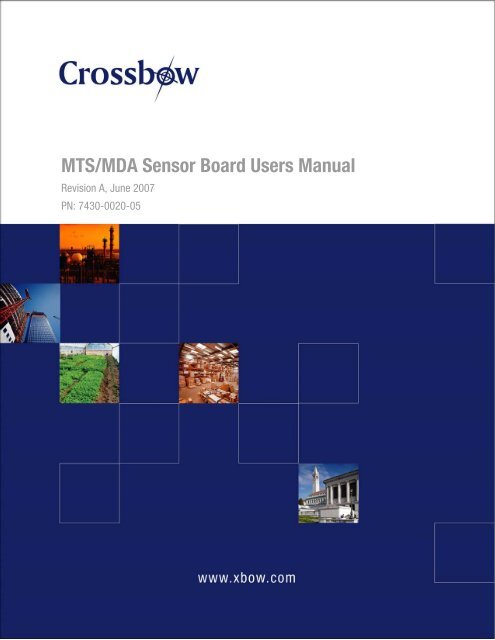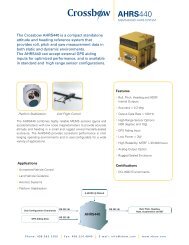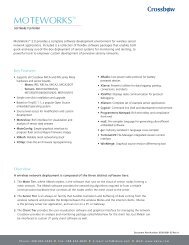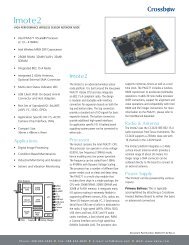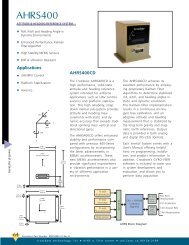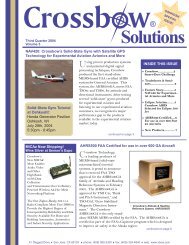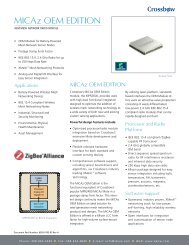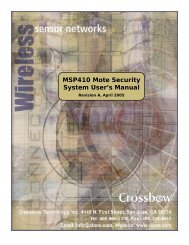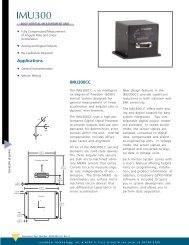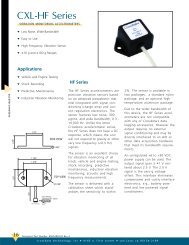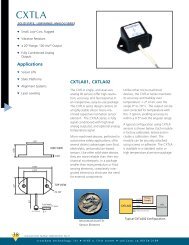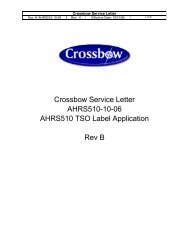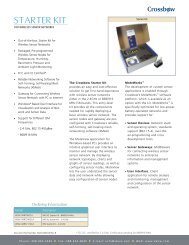MTS/MDA Sensor Board Users Manual
MTS/MDA Sensor Board Users Manual
MTS/MDA Sensor Board Users Manual
Create successful ePaper yourself
Turn your PDF publications into a flip-book with our unique Google optimized e-Paper software.
<strong>MTS</strong>/<strong>MDA</strong> <strong>Sensor</strong> <strong>Board</strong> <strong>Users</strong> <strong>Manual</strong><br />
Revision A, June 2007<br />
PN: 7430-0020-05
© 2002-2007 Crossbow Technology, Inc. All rights reserved.<br />
Information in this document is subject to change without notice.<br />
Crossbow, MoteWorks, IRIS, MICA, TrueMesh and XMesh are the trademarks of Crossbow<br />
Technology, Inc. Other product and trade names are trademarks or registered trademarks of their<br />
respective holders.
<strong>MTS</strong>/<strong>MDA</strong> <strong>Sensor</strong> <strong>Board</strong> User’s <strong>Manual</strong><br />
Table of Contents<br />
1 Introduction.............................................................................................................................1<br />
2 <strong>MTS</strong>101CA..............................................................................................................................2<br />
2.1 Thermistor......................................................................................................................2<br />
2.2 Conversion to Engineering Units................................................................................... 3<br />
2.3 Light <strong>Sensor</strong>................................................................................................................... 3<br />
2.4 Prototyping Area............................................................................................................ 4<br />
3 <strong>MTS</strong>300/<strong>MTS</strong>310....................................................................................................................6<br />
3.1 Microphone.................................................................................................................... 6<br />
3.2 Sounder.......................................................................................................................... 7<br />
3.3 Light and Temperature................................................................................................... 7<br />
3.4 2-Axis Accelerometer (<strong>MTS</strong>310 Only) ......................................................................... 8<br />
3.5 Two-Axis Magnetometer (<strong>MTS</strong>310 Only) .................................................................... 8<br />
3.6 Turning <strong>Sensor</strong>s On and Off.......................................................................................... 9<br />
3.7 Schematics of the <strong>MTS</strong>300 and <strong>MTS</strong>310.................................................................... 10<br />
4 <strong>MTS</strong>400/<strong>MTS</strong>420..................................................................................................................15<br />
4.1 Humidity and Temperature <strong>Sensor</strong> .............................................................................. 15<br />
4.2 Barometric Pressure and Temperature <strong>Sensor</strong>............................................................. 16<br />
4.3 Light <strong>Sensor</strong>................................................................................................................. 16<br />
4.4 2-Axis Accelerometer .................................................................................................. 17<br />
4.5 GPS (<strong>MTS</strong>420 only) .................................................................................................... 17<br />
4.6 Turning <strong>Sensor</strong>s On and Off........................................................................................ 18<br />
4.7 Schematics of the <strong>MTS</strong>400 and <strong>MTS</strong>420.................................................................... 18<br />
5 <strong>MTS</strong>510CA............................................................................................................................19<br />
5.1 Microphone.................................................................................................................. 19<br />
5.2 Light............................................................................................................................. 19<br />
5.3 2-Axis Accelerometer .................................................................................................. 19<br />
6 <strong>MDA</strong>100CA/<strong>MDA</strong>100CB.....................................................................................................21<br />
6.2 Conversion to Engineering Units................................................................................. 22<br />
6.3 Light <strong>Sensor</strong>................................................................................................................. 23<br />
6.4 Prototyping Area.......................................................................................................... 23<br />
7 <strong>MDA</strong>300CA...........................................................................................................................25<br />
7.1 Theory of Operation..................................................................................................... 26<br />
8 <strong>MDA</strong>320CA...........................................................................................................................29<br />
8.1 Theory of Operation..................................................................................................... 30<br />
Doc. # 7430-0020-05 Rev. A Page i
<strong>MTS</strong>/<strong>MDA</strong> <strong>Sensor</strong> <strong>Board</strong> User’s <strong>Manual</strong><br />
9 <strong>MDA</strong>500CA...........................................................................................................................33<br />
10 Appendix A: TinyOS Drivers and Test Firmware .........................................................34<br />
10.1 Testing a <strong>Sensor</strong> or Data Acquisition <strong>Board</strong>............................................................ 34<br />
11 Appendix B. Warranty and Support Information..........................................................35<br />
11.1 Customer Service ..................................................................................................... 35<br />
11.2 Contact Directory ..................................................................................................... 35<br />
11.3 Return Procedure...................................................................................................... 35<br />
11.4 Warranty................................................................................................................... 36<br />
Page ii Doc. # 7430-0020-05 Rev. A
<strong>MTS</strong>/<strong>MDA</strong> <strong>Sensor</strong> <strong>Board</strong> User’s <strong>Manual</strong><br />
About This Document<br />
The following annotations have been used to provide additional information.<br />
NOTE<br />
Note provides additional information about the topic.<br />
EXAMPLE<br />
Examples are given throughout the manual to help the reader understand the terminology.<br />
IMPORTANT<br />
This symbol defines items that have significant meaning to the user<br />
WARNING<br />
The user should pay particular attention to this symbol. It means there is a chance that physical<br />
harm could happen to either the person or the equipment.<br />
The following paragraph heading formatting is used in this manual:<br />
1 Heading 1<br />
1.1 Heading 2<br />
1.1.1 Heading 3<br />
This document also uses different body text fonts (listed in Table 0-1) to help you distinguish<br />
between names of files, commands to be typed, and output coming from the computer.<br />
Table 0-1. Font types used in this document.<br />
Font Type Usage<br />
Courier New Normal Sample code and screen output<br />
Courier New Bold Commands to be typed by the user<br />
Times New Roman Italic TinyOS files names, directory names<br />
Franklin Medium Condensed Text labels in GUIs<br />
Doc. # 7430-0020-05 Rev. A Page iii
<strong>MTS</strong>/<strong>MDA</strong> <strong>Sensor</strong> <strong>Board</strong> User’s <strong>Manual</strong><br />
1 Introduction<br />
The <strong>MTS</strong> series of sensor boards and <strong>MDA</strong> series of sensor/data acquisition boards are designed<br />
to interface with Crossbow’s MICA, MICA2, and MICA2DOT family of wireless Motes. There<br />
are a variety of sensor boards available, and the sensor boards are specific to the MICA, MICA2<br />
board or the MICA2DOT form factor. The sensor boards allow for a range of different sensing<br />
modalities as well as interface to external sensor via prototyping areas or screw terminals. The<br />
following table lists the currently available sensor boards for each Mote family.<br />
Chapter<br />
Crossbow Part<br />
Name<br />
Table 1-1. Crossbow’s <strong>Sensor</strong> and Data Acquisition <strong>Board</strong>s.<br />
2 <strong>MTS</strong>101CA MICAz, MICA2,<br />
MICA<br />
3 <strong>MTS</strong>300CA<br />
<strong>MTS</strong>300CB<br />
3 <strong>MTS</strong>310CA<br />
<strong>MTS</strong>310CB<br />
4 <strong>MTS</strong>400CA<br />
<strong>MTS</strong>400CB<br />
<strong>MTS</strong>400CC<br />
4 <strong>MTS</strong>420CA<br />
<strong>MTS</strong>420CB<br />
<strong>MTS</strong>420CC<br />
Motes Supported <strong>Sensor</strong>s and Features<br />
IRIS, MICAz,<br />
MICA2, MICA<br />
IRIS, MICAz,<br />
MICA2, MICA<br />
IRIS, MICAz,<br />
MICA2<br />
IRIS, MICAz,<br />
MICA2<br />
Light, temperature, prototyping area<br />
Light, temperature, microphone, and buzzer<br />
Light, temperature, microphone, buzzer, 2-axis<br />
accelerometer, and 2-axis magnetometer<br />
Ambient light, relative humidity, temperature, 2-axis<br />
accelerometer, and barometric pressure<br />
Same as <strong>MTS</strong>400CA plus a GPS module<br />
5 <strong>MTS</strong>510CA MICA2DOT Light, microphone, and 2-axis accelerometer<br />
6 <strong>MDA</strong>100CA<br />
<strong>MDA</strong>100CB<br />
IRIS, MICAz,<br />
MICA2<br />
7 <strong>MDA</strong>300CA IRIS, MICAz,<br />
MICA2<br />
8 <strong>MDA</strong>320CA IRIS, MICAz,<br />
MICA2<br />
9 <strong>MDA</strong>500CA MICA2DOT Prototyping area<br />
Light, temperature, prototyping area<br />
Light, relative humidity, general purpose interface<br />
for external sensors<br />
General purpose interface for external sensors<br />
Doc. # 7430-0020-05 Rev. A Page 1
2 <strong>MTS</strong>101CA<br />
<strong>MTS</strong>/<strong>MDA</strong> <strong>Sensor</strong> <strong>Board</strong> User’s <strong>Manual</strong><br />
The <strong>MTS</strong>101CA series sensor boards have a precision thermistor, a light sensor/photocell, and<br />
general prototyping area. The prototyping area supports connection to five channels of the<br />
Mote’s analog to digital converter (ADC3–7) and the I2C digital communications bus. The<br />
prototyping area also has 24 unconnected holes that are used for breadboard of circuitry.<br />
2.1 Thermistor<br />
The thermistor, (YSI 44006, http://www.ysi.com) sensor is a highly accurate and highly stable<br />
sensor element. With proper calibration, an accuracy of 0.2 °C can be achieved. The resistance of<br />
the thermistor varies with temperature. (See Table 2-1 and the resistance vs. temperature graph in<br />
Figure 2-2.) This curve, although non-linear, is very repeatable. The sensor is connected to the<br />
analog-digital converter channel number 5 (ADC5, U1 pin 38) thru a basic resistor divider<br />
circuit. In order to use the thermistor, the sensor must be enabled by setting digital control line<br />
PW2 high. See the circuit below.<br />
Table 2-1. Thermistor Specifications<br />
Type YSI 44006<br />
Time Constant 10 seconds, still air<br />
Base Resistance 10 kΩ at 25 °C<br />
Repeatability 0.2 °C<br />
RT1 Thermistor<br />
R3, 10 k, 5%<br />
PW2<br />
Figure 2-1. Thermistor Schematic<br />
Page 2 Doc. # 7430-0020-05 Rev. A<br />
ADC5<br />
Gnd_analog
<strong>MTS</strong>/<strong>MDA</strong> <strong>Sensor</strong> <strong>Board</strong> User’s <strong>Manual</strong><br />
Table 2-2. Resistance vs. Temperature, ADC5 Reading<br />
Temperature<br />
(°C)<br />
Resistance<br />
(Ohms)<br />
ADC5 Reading<br />
(% of VCC)<br />
-40 239,800 4%<br />
-20 78,910 11%<br />
0 29,940 25%<br />
25 10,000 50%<br />
40 5592 64%<br />
60 2760 78%<br />
70 1990 83%<br />
300,000<br />
250,000<br />
200,000<br />
150,000<br />
100,000<br />
50,000<br />
0<br />
Resistance (RT1 Ohms)<br />
-60 -40 -20 0 20 40 60 80 100 120<br />
Temperature (Deg. C)<br />
Figure 2-2. Resistance vs. Temperature Graph<br />
2.2 Conversion to Engineering Units<br />
The Mote’s ADC output can be converted to Kelvin using the following approximation over 0 to<br />
50 °C:<br />
1/T(K) = a + b × ln(Rthr) + c × [ln(Rthr)] 3<br />
where:<br />
Rthr = R1(ADC_FS-ADC)/ADC<br />
a = 0.001010024<br />
b = 0.000242127<br />
c = 0.000000146<br />
R1 = 10 kΩ<br />
ADC_FS = 1023, and<br />
ADC = output value from Mote’s ADC measurement.<br />
2.3 Light <strong>Sensor</strong><br />
The light sensor is a CdSe photocell. The maximum sensitivity of the photocell is at the light<br />
wavelength of 690 nm. Typical on resistance, while exposed to light, is 2 kΩ. Typical off<br />
Doc. # 7430-0020-05 Rev. A Page 3
<strong>MTS</strong>/<strong>MDA</strong> <strong>Sensor</strong> <strong>Board</strong> User’s <strong>Manual</strong><br />
resistance, while in dark conditions, is 520 kΩ. In order to use the light sensor, digital control<br />
signal PW1 must be turned on. The output of the sensor is connected to the analog-digital<br />
converter channel 6 (ADC6, U1 Pin 37). See the circuit below.<br />
R2 Photoresistor<br />
R3, 10 k, 5%<br />
Page 4 Doc. # 7430-0020-05 Rev. A<br />
PW1<br />
Gnd_analog<br />
ADC6<br />
Figure 2-3. Schematic of the light sensor.<br />
Table 2-3. Light <strong>Sensor</strong> Specifications.<br />
Type Clairex CL94L<br />
RON 2 kΩ<br />
ROFF 520 kΩ<br />
2.4 Prototyping Area<br />
The prototyping area is a series of solder holes and connection points for connecting other<br />
sensors and devices to the Mote. The prototyping area layout is shown in the diagram and tables<br />
below.<br />
Table 2-4. Connection Table for <strong>MTS</strong>101CA. Use the photo (top view) below the table to locate the pins.<br />
a1-a12 No Connect, Bare Hole c1-c12 No Connect, Bare Hole<br />
b1 PW4 (U1-33) b9 I2C_BUS_DATA (U1-22)<br />
b2 PW5 (U1-34) b10 I2C_BUS_CLK (U1-21)<br />
b3 PW6 (U1-35) b11 FLASH_SO (U1-19)<br />
b4 ADC3 (U1-36) b12 FLASH_SI (U1-20)<br />
d1 GND_ANALOG (U1-1) d9 GND (U1-51)<br />
d2 VDD_ANALOG (U1-2) d10 VCC (U1-50)<br />
d3 ADC1 (U1-42) d11 No Connect, Bare Hole<br />
d4 ADC2 (U1-41) d12 No Connect, Bare Hole<br />
e9 PW3 (U1-32) e11 ADC0 (U1-43)<br />
e10 ADC4 (U1-39) e12 GND_ANALOG (U1-1)<br />
a b c d e<br />
a b c d e<br />
1<br />
2<br />
3<br />
4<br />
5<br />
6<br />
7<br />
8<br />
9<br />
10<br />
11<br />
12<br />
Thermistor<br />
Light <strong>Sensor</strong>
<strong>MTS</strong>/<strong>MDA</strong> <strong>Sensor</strong> <strong>Board</strong> User’s <strong>Manual</strong><br />
NOTE: If you have downloaded the PDF schematic of the Rene basic sensor board from UC Berkeley,<br />
you will see that the A/D channels appear in reverse order. This is due to a difference in wiring between<br />
the original Rene Mote and the MICA/MICA2 family of Motes.<br />
WARNING: Never connect signals that are greater than VCC (3V typical) or less than 0 V<br />
to any of the holes that connect to the Mote Processor Radio board. It is okay to connect<br />
different voltages to the non-connected holes. However, be careful. If a voltage out of the<br />
range of 0 to VCC should reach the Mote Processor Radio <strong>Board</strong> damage will occur.<br />
Doc. # 7430-0020-05 Rev. A Page 5
3 <strong>MTS</strong>300/<strong>MTS</strong>310<br />
<strong>MTS</strong>/<strong>MDA</strong> <strong>Sensor</strong> <strong>Board</strong> User’s <strong>Manual</strong><br />
<strong>MTS</strong>300CA/<strong>MTS</strong>310CA and <strong>MTS</strong>300CB/<strong>MTS</strong>310CB have the same content in this chapter<br />
except for some minor changes.<br />
The <strong>MTS</strong>300 (Figure 3-1a) and <strong>MTS</strong>310 (Figure 3-1b) are flexible sensor boards with a variety<br />
of sensing modalities. These modalities can be exploited in developing sensor networks for a<br />
variety of applications including vehicle detection, low-performance seismic sensing, movement,<br />
acoustic ranging, robotics, and other applications. The following section of the User’s <strong>Manual</strong><br />
describes the sensor circuits and general application. Please refer to the schematic diagram at end<br />
of section for exact circuit details.<br />
(a) (b)<br />
Analog Devices<br />
ADXL202JE<br />
Accelerometer<br />
Honeywell<br />
HMC1002<br />
Magnetometer<br />
Figure 3-1. (a) <strong>MTS</strong>300 and (b) <strong>MTS</strong>310 with the accelerometer and magnetometer highlighted<br />
3.1 Microphone<br />
The microphone circuit has two principal uses: First is for acoustic ranging and second is for<br />
general acoustic recording and measurement. The basic circuit consists of a pre-amplifier (U1A-<br />
1), second-stage amplified with a digital-pot control (U1A, PT2).<br />
This circuit amplifies the low-level microphone output. This output can be fed directly into the<br />
analog-digital converter (ADC2) by using the Microphone Output selector circuit (MX1) to<br />
connect mic_out signal to ADC2 signal. This configuration is useful for general acoustic<br />
recording and measurement. Audio files have been recorded into the logger flash memory of<br />
MICAz, MICA2, or MICA Motes for later download and entertainment (or analysis!).<br />
The second stage output (mic_out) is routed thru an active filter (U2) and then into a tone<br />
detector (TD1). The LM567 CMOS Tone Detector IC actually turns the analog microphone<br />
signal into a digital high or low level output at INT3 when a 4 kHz tone is present. The Sounder<br />
circuit on the sensor board can generate this tone.<br />
A novel application of the sounder and tone detector is acoustic ranging. In this application, a<br />
Mote pulses the sounder and sends an RF packet via radio at the same time. A second Mote<br />
listens for the RF packet and notes the time of arrival by resetting a timer/counter on its<br />
processor. It then increments a counter until the tone detector detects the sounder. The counter<br />
value is the time-of-flight of the sound wave between the two Motes. The time-of-flight value<br />
can be converted into an approximate distance between Motes. Using groups of Motes with<br />
Sounders and Microphones, a crude localization and positioning system can be built<br />
Page 6 Doc. # 7430-0020-05 Rev. A
<strong>MTS</strong>/<strong>MDA</strong> <strong>Sensor</strong> <strong>Board</strong> User’s <strong>Manual</strong><br />
NOTE: Motes are designed for power efficiency. Hence all the sensors are disconnected from power<br />
on the <strong>MTS</strong>300 and <strong>MTS</strong>310 sensor boards unless specifically turned on. See Section 3.6 for more<br />
information.<br />
3.2 Sounder<br />
The sounder or “buzzer” is a simple 4 kHz fixed frequency piezoelectric resonator. The drive and<br />
frequency control circuitry is built into the sounder. The only signal required to turn the sounder<br />
on and off, is Sounder_Power. Sounder_Power is controlled thru the power control switch (P1)<br />
and is set by the hardware line PW2.<br />
3.3 Light and Temperature<br />
NOTE: The light and temperature sensor share the same A/D converter channel (ADC1). Only turn<br />
one sensor on at a time, or the reading at ADC1 will be corrupted and meaningless.<br />
The <strong>MTS</strong>300 and <strong>MTS</strong>310 sensor boards have a light sensor and a thermistor.<br />
The light sensor is a simple CdSe photocell. The maximum sensitivity of the photocell is at the<br />
light wavelength of 690 nm. Typical on resistance, while exposed to light, is 2 kΩ. Typical off<br />
resistance, while in dark conditions, is 520 kΩ. In order to use the light sensor, digital control<br />
signal PW1 must be turned on. The output of the sensor is connected to the analog-digital<br />
converter channel 1 (ADC1). When there is light, the nominal circuit output is near VCC or fullscale,<br />
and when it is dark the nominal output is near GND or zero. Power is controlled to the<br />
light sensor by setting signal INT1.<br />
The thermistor (Panasonic ERT-J1VR103J) on the <strong>MTS</strong>300 and <strong>MTS</strong>310 is a surface mount<br />
component installed at location RT2. It is configured in a simple voltage divider circuit with a<br />
nominal mid-scale reading at 25°C. The output of the temperature sensor circuit is available at<br />
ADC1.<br />
For <strong>MTS</strong>300CA and <strong>MTS</strong>310CA, the thermistor power is controlled by setting signal INT2.<br />
For <strong>MTS</strong>300CB and <strong>MTS</strong>310CB, the thermistor power is controlled by setting signal PW0.<br />
Table 3-1. Voltage, Resistance vs. Temperature<br />
Temperature Resistance ADC1 Reading<br />
(°C) (Ohms)<br />
(% of VCC)<br />
-40 427,910 2.3%<br />
-20 114,200 8.1%<br />
0 35,670 22%<br />
25 10,000 50%<br />
40 4090 71%<br />
60 2224 82%<br />
70 1520 87%<br />
3.3.1 Conversion to Engineering Units<br />
The Mote’s ADC output can be converted to degrees Kelvin using the following approximation<br />
over 0-50 °C:<br />
1/T(K) = a + b × ln(Rthr) + c × [ln(Rthr)] 3<br />
Doc. # 7430-0020-05 Rev. A Page 7
where:<br />
Rthr = R1(ADC_FS-ADC)/ADC<br />
a = 0.00130705<br />
b = 0.000214381<br />
c = 0.000000093<br />
R1 = 10 kΩ<br />
ADC_FS = 1023<br />
ADC = output value from Mote’s ADC measurement.<br />
<strong>MTS</strong>/<strong>MDA</strong> <strong>Sensor</strong> <strong>Board</strong> User’s <strong>Manual</strong><br />
3.4 2-Axis Accelerometer (<strong>MTS</strong>310 Only)<br />
The accelerometer is a MEMS surface micro-machined 2-axis, ± 2 g device. It features very low<br />
current draw (< 1mA) and 10-bit resolution. The sensor can be used for tilt detection, movement,<br />
vibration, and/or seismic measurement. Power is controlled to the accelerometer by setting signal<br />
PW4, and the analog data is sampled on ADC3 and ADC4. The accelerometer at location U5 is<br />
an ADXL202JE and the full datasheet is available at http://www.analog.com. A summary of<br />
specification is provided in Table 3-2 below for reference.<br />
Table 3-2. Summary of ADXL202JE Specifications.<br />
Channels X (ADC3), Y (ADC4)<br />
G-range ±2 g (1 g = 9.81 m/s 2 )<br />
Bandwidth DC-50 Hz (controlled by C20, C21)<br />
Resolution 2 mG (0.002 G) RMS<br />
Sensitivity 167 mV/G ±17 %<br />
Offset 2.5 V ±0.4 V<br />
NOTE: The ADXL202 sensitivity and offset have a wide initial tolerance. A simple calibration using<br />
earth’s gravitational field can greatly enhance the accuracy of the ADXL202 sensor. By rotating the<br />
sensor into a +1 G and a –1 G position, the offset and sensitivity can be calculated to within 1 %.<br />
3.5 Two-Axis Magnetometer (<strong>MTS</strong>310 Only)<br />
The magnetometer circuit is a silicon sensor that has a unique bridge resistor coated in a highly<br />
sensitive NiFe coating. This NiFe coating causes the bridge resistance of the circuit to change.<br />
The bridge is highly sensitive and can measure the Earth’s field and other small magnetic fields.<br />
A useful application is vehicle detection. Successful test have detected disturbances from<br />
automobiles at a radius of 15 feet. The sensor is the Honeywell HMC1002 sensor. A detailed<br />
specification sheet is found at http://www.ssec.honeywell.com. The output of each axis (X, Y) is<br />
amplified by an instrumentation amplifier U6, U7. The amplified output is available at ADC5<br />
and ADC6. Power is controlled to the magnetometers by setting signal PW5. Each<br />
instrumentation amplifier (U6, U7) can be tuned using the digital potentiometer PT1 that is<br />
controlled via the I2C bus.<br />
WARNING: The NiFe core of the magnetic sensor is extremely sensitive. However, it is also<br />
subject to saturation. Saturation occurs when the sensor is exposed to a large magnetic field.<br />
Unfortunately the <strong>MTS</strong>310 circuit does not have an automatic saturation recovery circuit<br />
(set/reset). This limitation prevents the magnetometer from being useful in applications<br />
Page 8 Doc. # 7430-0020-05 Rev. A
<strong>MTS</strong>/<strong>MDA</strong> <strong>Sensor</strong> <strong>Board</strong> User’s <strong>Manual</strong><br />
requiring DC response (for example compassing). There are four pads label S/R (Set/Reset)<br />
available on the PCB for adding an external set/reset circuit.<br />
3.6 Turning <strong>Sensor</strong>s On and Off<br />
All of the sensors have a power control circuit. The default condition for the sensor is off. This<br />
design helps minimize power draw by the sensor board.<br />
In order to turn sensors on, control signals are issued to the power switches. Table 3-3 below lists<br />
the control settings.<br />
Table 3-3. Control Settings for the Sounder and <strong>Sensor</strong>s<br />
<strong>Sensor</strong>/Actuator Control Signal<br />
Sounder PW2<br />
Microphone PW3<br />
Accelerometer PW4<br />
Magnetometer PW5<br />
Temperature (RT2) INT2/PW0 1<br />
Photocell (R2) INT1<br />
Temperature(RT2)(<strong>MTS</strong>300CB/<strong>MTS</strong>310CB) PW0<br />
NOTE: Only one of the INT1 and INT2/PW0 signals should be activated at a time. See Section 3.3.<br />
1 For <strong>MTS</strong>300CA and <strong>MTS</strong>310CA, the RT2 power is controlled by setting signal INT2. For<br />
<strong>MTS</strong>300CB and <strong>MTS</strong>310CB, the RT2 power is controlled by setting signal PW0.<br />
Doc. # 7430-0020-05 Rev. A Page 9
3.7 Schematics of the <strong>MTS</strong>300 and <strong>MTS</strong>310<br />
U0<br />
52<br />
53<br />
Pin 52<br />
Pin 53<br />
Connector (Top)<br />
gnd_analog<br />
1<br />
27 UART_RXD0<br />
VDD_ANALOG 2<br />
Pin 1 Pin 27<br />
28 UART_TXD0<br />
INT3<br />
3<br />
Pin 2 Pin 28<br />
29 PW0<br />
INT2<br />
4<br />
Pin 3 Pin 29<br />
30 PW1<br />
INT1<br />
5<br />
Pin 4 Pin 30<br />
31 PW2<br />
INT0<br />
6<br />
Pin 5 Pin 31<br />
32 PW3<br />
DC_BOOST_SHUTDOWN 7<br />
Pin 6 Pin 32<br />
33 PW4<br />
LED3<br />
8<br />
Pin 7 Pin 33<br />
34 PW5<br />
LED2<br />
9<br />
Pin 8 Pin 34<br />
35 PW6<br />
LED1<br />
10<br />
Pin 9 Pin 35<br />
36 ADC7<br />
RD<br />
11<br />
Pin 10 Pin 36<br />
37 ADC6<br />
WR<br />
12<br />
Pin 11 Pin 37<br />
38 ADC5<br />
ALE<br />
13<br />
Pin 12 Pin 38<br />
39 ADC4<br />
PW7<br />
14<br />
Pin 13 Pin 39<br />
40 ADC3<br />
FLASH_CLK 15<br />
Pin 14 Pin 40<br />
41 ADC2<br />
PROG_MOSI_SPI 16<br />
Pin 15 Pin 41<br />
42 ADC1<br />
PROG_MISO_SPI 17<br />
Pin 16 Pin 42<br />
43 ADC0_BBOut<br />
SCK_SPI 18<br />
Pin 17 Pin 43<br />
44 Little_Guy_Reset<br />
FLASH_SO<br />
19<br />
Pin 18 Pin 44<br />
45 Little_Guy_SPI_Clock<br />
FLASH_SI<br />
20<br />
Pin 19 Pin 45<br />
46 Little_Guy_MISO<br />
I2C_BUS_1_CLK 21<br />
Pin 20 Pin 46<br />
47 Little_Guy_MOSI<br />
I2C_BUS_1_DATA 22<br />
Pin 21 Pin 47<br />
48 RESET<br />
PWM0<br />
23<br />
Pin 22 Pin 48<br />
49 PWM1B<br />
PWM1A<br />
24<br />
Pin 23 Pin 49<br />
50<br />
AC+<br />
25<br />
Pin 24 Pin 50<br />
51<br />
AC-<br />
26<br />
Pin 25 Pin 51<br />
Pin 26<br />
Connector to Mica<br />
(Bottom)<br />
gnd_analog<br />
26<br />
VDD_ANALOG 25<br />
Pin 26<br />
INT3<br />
24<br />
Pin 25 Pin 51<br />
INT2<br />
23<br />
Pin 24 Pin 50<br />
INT1<br />
22<br />
Pin 23 Pin 49<br />
INT0<br />
21<br />
Pin 22 Pin 48<br />
DC_BOOST_SHUTDOWN20<br />
Pin 21 Pin 47<br />
LED3<br />
19<br />
Pin 20 Pin 46<br />
LED2<br />
18<br />
Pin 19 Pin 45<br />
LED1<br />
17<br />
Pin 18 Pin 44<br />
RD<br />
16<br />
Pin 17 Pin 43<br />
WR<br />
15<br />
Pin 16 Pin 42<br />
ALE<br />
14<br />
Pin 15 Pin 41<br />
PW7<br />
13<br />
Pin 14 Pin 40<br />
FLASH_CLK<br />
12<br />
Pin 13 Pin 39<br />
PROG_MOSI_SPI 11<br />
Pin 12 Pin 38<br />
PROG_MISO_SPI 10<br />
Pin 11 Pin 37<br />
SCK_SPI<br />
9<br />
Pin 10 Pin 36<br />
FLASH_SO<br />
8<br />
Pin 9 Pin 35<br />
FLASH_SI<br />
7<br />
Pin 8 Pin 34<br />
I2C_BUS_1_CLK 6<br />
Pin 7 Pin 33<br />
I2C_BUS_1_DATA 5<br />
Pin 6 Pin 32<br />
PWM0<br />
4<br />
Pin 5 Pin 31<br />
PWM1A<br />
3<br />
Pin 4 Pin 30<br />
AC+<br />
2<br />
Pin 3 Pin 29<br />
AC-<br />
1<br />
Pin 2 Pin 28<br />
Pin 1 Pin 27<br />
Pin 52<br />
Pin 53<br />
52<br />
53<br />
51<br />
50<br />
49<br />
48<br />
47<br />
46<br />
45<br />
44<br />
43<br />
42<br />
41<br />
40<br />
39<br />
38<br />
37<br />
36<br />
35<br />
34<br />
33<br />
32<br />
31<br />
30<br />
29<br />
28<br />
27<br />
UART_RXD0<br />
UART_TXD0<br />
PW0<br />
PW1<br />
PW2<br />
PW3<br />
PW4<br />
PW5<br />
PW6<br />
ADC7<br />
ADC6<br />
ADC5<br />
ADC4<br />
ADC3<br />
ADC2<br />
ADC1<br />
ADC0_BBOut<br />
Little_Guy_Reset<br />
Little_Guy_SPI_Clock<br />
Little_Guy_MISO<br />
Little_Guy_MOSI<br />
RESET<br />
PWM1B<br />
<strong>MTS</strong>/<strong>MDA</strong> <strong>Sensor</strong> <strong>Board</strong> User’s <strong>Manual</strong><br />
J6<br />
1connector 1<br />
1<br />
Page 10 Doc. # 7430-0020-05 Rev. A<br />
Vcc<br />
Vcc<br />
Mounting Holes<br />
J5<br />
1connector 1<br />
1<br />
Figure 3-2. <strong>MTS</strong>300/310 Schematic of 51-pin connector pin-outs
<strong>MTS</strong>/<strong>MDA</strong> <strong>Sensor</strong> <strong>Board</strong> User’s <strong>Manual</strong><br />
gnd_analog<br />
Temperature<br />
C1<br />
100nF<br />
ADC1<br />
INT2<br />
ADC3<br />
ADC4<br />
RT1<br />
t<br />
U5<br />
7<br />
XFILT<br />
6<br />
INT2<br />
t<br />
2 Axis<br />
Acceleromemter<br />
YFILT<br />
R3<br />
10k 1%<br />
C20<br />
100nF<br />
5<br />
XOUT COM<br />
3<br />
R26<br />
ADXL202E<br />
C21<br />
100nF<br />
330K<br />
gnd_analog<br />
gnd_analog<br />
2<br />
2<br />
PD2<br />
2conPads<br />
RT2<br />
8<br />
YOUT VDD<br />
4<br />
1<br />
1<br />
Light<br />
INT1<br />
ST<br />
T2<br />
R25<br />
100<br />
1<br />
2<br />
C2<br />
100nF<br />
R2<br />
Title<br />
gnd_analog<br />
Acce Power<br />
C19<br />
100nF<br />
<strong>MTS</strong>310CA SENSOR BOARD<br />
Power<br />
Switches<br />
PW2<br />
PW3<br />
PW4<br />
PW5<br />
Size Document Number Rev<br />
B 8000-0212 A<br />
Date: Monday, March 03, 2003<br />
Sheet 1 of 1<br />
SB_VDD_ANALOG<br />
Doc. # 7430-0020-05 Rev. A Page 11<br />
P1<br />
1<br />
IN1<br />
16<br />
9<br />
8<br />
R22<br />
200k<br />
R23<br />
3.9k<br />
4kHz<br />
Sounder<br />
IN2<br />
IN3<br />
IN4<br />
12<br />
MAX4678<br />
VL<br />
V-<br />
4<br />
13<br />
V+<br />
GND<br />
5<br />
R24<br />
560<br />
Vcc<br />
NO1<br />
COM1<br />
NO2<br />
COM2<br />
NO3<br />
COM3<br />
NO4<br />
COM4<br />
Sounder Power<br />
T0<br />
2N2222A<br />
M<br />
M<br />
PS14T40A<br />
gnd_analog<br />
3<br />
2<br />
14<br />
15<br />
11<br />
10<br />
6<br />
7<br />
S1<br />
G<br />
G<br />
Vcc<br />
Sounder Power<br />
SB_VDD_ANALOG<br />
Mic Power<br />
MAG_VDD_ANALOG<br />
Mag Power<br />
F<br />
Acce Power<br />
F<br />
gnd_analog<br />
C3<br />
10uF 1206<br />
Figure 3-3(a). <strong>MTS</strong>310CA Schematics of Accelerometer, Sounder, Temperature and Light <strong>Sensor</strong>s, and<br />
Power Switches<br />
Temperature<br />
C1<br />
100nF<br />
gnd_analog<br />
PW0<br />
t<br />
RT1<br />
THERMISTOR<br />
ADC1<br />
PW0<br />
t<br />
R3<br />
10k 1%<br />
gnd_analog<br />
RT2<br />
THERMISTOR<br />
Light<br />
INT1<br />
C2<br />
100nF<br />
gnd_analog<br />
R2<br />
Photo Resistor 100mil<br />
Figure 3-4(b). Power Controlled Signal of <strong>MTS</strong>300CB/<strong>MTS</strong>310CB Temperature and Light <strong>Sensor</strong>s
R36<br />
3.3k<br />
MAG_VREF<br />
U9<br />
1<br />
16<br />
2<br />
VinA- VinB-<br />
15<br />
3<br />
VinA+ VinB+<br />
14<br />
4<br />
RGA1 RGB2<br />
13<br />
5<br />
RGA2 RGB1<br />
12<br />
6<br />
RefA RefB<br />
11<br />
7<br />
VoutA VoutB<br />
10<br />
8<br />
SenseA SenseB<br />
9<br />
V- V+<br />
Vcc<br />
INA2126<br />
MAG_VDD_ANALOG<br />
R33<br />
39 K<br />
U8<br />
1<br />
20 S/R-_A<br />
2<br />
GND1 (A) S/R- (A)<br />
19<br />
3<br />
OUT+(A)<br />
NC<br />
18<br />
C30<br />
4<br />
OFFSET-(A) GND PLN<br />
17<br />
1uF 5<br />
Vbridge (A) OFFSET+ (A)<br />
16 S/R+_A<br />
6<br />
OUT- (A) S/R+ (A)<br />
15<br />
S/R-_B 7<br />
GND2 (A) OFFSET+ (B)<br />
14 S/R+_B<br />
8<br />
S/R- (B) S/R+ (B)<br />
13<br />
9<br />
GND1 (B) GND2 (B)<br />
12<br />
10<br />
OUT+ (B) OUT- (B)<br />
11<br />
OFFSET- (B) Vbridge (B)<br />
Mag Power<br />
R51<br />
0ohm<br />
C28<br />
10uF<br />
gnd_analog<br />
Vcc<br />
PW5<br />
I2C_BUS_1_CLK<br />
I2C_BUS_1_DATA<br />
Magnetometer<br />
HMC1002<br />
MAG_VREF<br />
R35<br />
20k<br />
Mag Power<br />
C25<br />
1uF<br />
Mag Power<br />
R55<br />
R32<br />
39 K<br />
R34<br />
1.1k<br />
ADC5<br />
C23<br />
1uF<br />
20k<br />
1<br />
2<br />
3<br />
4<br />
5<br />
6<br />
7<br />
8<br />
PT1<br />
O1 A2<br />
A1 W2<br />
W1 B2<br />
B1 O2<br />
VDD Vss<br />
SHDN DGND<br />
SCL AD1<br />
SDA AD0<br />
16<br />
15<br />
14<br />
13<br />
12<br />
11<br />
10<br />
9<br />
AD5242<br />
<strong>MTS</strong>/<strong>MDA</strong> <strong>Sensor</strong> <strong>Board</strong> User’s <strong>Manual</strong><br />
Page 12 Doc. # 7430-0020-05 Rev. A<br />
C31<br />
1uF<br />
R31<br />
3.3k<br />
MAG_VREF<br />
R28<br />
39 K<br />
R27<br />
39 K<br />
Title<br />
Size<br />
<strong>MTS</strong>310 SENSOR BOARD<br />
Document Number Rev<br />
B 8000-0212 A<br />
Date: Wednesday, March 26, 2003 Sheet 1 of 1<br />
PD1<br />
1<br />
1<br />
U7<br />
2<br />
2<br />
INA2126<br />
4conPads<br />
S/R-_A<br />
3<br />
3<br />
1<br />
16<br />
2<br />
VinA- VinB-<br />
15<br />
3<br />
VinA+ VinB+<br />
14<br />
4<br />
RGA1 RGB2<br />
13<br />
5<br />
RGA2 RGB1<br />
12<br />
6<br />
RefA RefB<br />
11<br />
7<br />
VoutA VoutB<br />
10<br />
8<br />
SenseA SenseB<br />
9<br />
V- V+<br />
R56<br />
20k<br />
S/R+_A<br />
Mag Power<br />
Mag Power<br />
3<br />
V1<br />
IN<br />
COM<br />
2<br />
S/R+_B<br />
OUT<br />
TLE2426<br />
4<br />
4<br />
MAG_VREF<br />
1<br />
Mag Power<br />
ADC6<br />
C22<br />
1uF<br />
S/R-_B<br />
R29<br />
1.1k<br />
R30<br />
20k<br />
Magnetometer<br />
Virtual Ground<br />
Figure 3-5. <strong>MTS</strong>310 Schematic of Magnetometer<br />
MAG_VREF<br />
C27<br />
1uF 0805
<strong>MTS</strong>/<strong>MDA</strong> <strong>Sensor</strong> <strong>Board</strong> User’s <strong>Manual</strong><br />
gnd_analog<br />
C29<br />
10uF<br />
M0<br />
Mic Power<br />
2 1<br />
GND OUT<br />
R54<br />
1.1k<br />
R8<br />
1.1k<br />
C7<br />
1uF<br />
WM-62A<br />
R13<br />
1k<br />
R9<br />
1k<br />
R20<br />
5.1k<br />
mic_out<br />
Vcc<br />
PW3<br />
I2C_BUS_1_CLK<br />
I2C_BUS_1_DATA<br />
VREF<br />
Microphone and<br />
Amplifier<br />
VREF<br />
56k<br />
R10<br />
U1A_1<br />
3<br />
1<br />
3<br />
1<br />
2 5<br />
GND Vcc<br />
-<br />
+<br />
Mic Power<br />
C24<br />
MAX4466<br />
2 5<br />
GND Vcc<br />
-<br />
+<br />
gnd_analog<br />
AD5242<br />
mic_preamp_out<br />
OUT<br />
1uF<br />
Mic Power<br />
U1A_2<br />
OUT<br />
MAX4466<br />
1<br />
2<br />
3<br />
4<br />
5<br />
6<br />
7<br />
8<br />
PT2<br />
O1 A2<br />
A1 W2<br />
W1 B2<br />
B1 O2<br />
VDD Vss<br />
SHDN DGND<br />
SCL AD1<br />
SDA AD0<br />
16<br />
15<br />
14<br />
13<br />
12<br />
11<br />
10<br />
9<br />
Doc. # 7430-0020-05 Rev. A Page 13<br />
4<br />
gnd_analog<br />
gnd_analog<br />
4<br />
R21 open<br />
Vcc<br />
mic_out<br />
R11<br />
1k<br />
C8<br />
20nF<br />
gnd_analog<br />
C9<br />
100nF<br />
gnd_analog<br />
R12<br />
Mic Power<br />
R52<br />
100k<br />
R53<br />
100k<br />
10k<br />
gnd_analog<br />
VREF<br />
1uF<br />
gnd_analog<br />
C10<br />
C26<br />
10uF<br />
Figure 3-6. <strong>MTS</strong>310 Schematic of Microphone and Amplifier
Biquad Active<br />
Filter<br />
mic_out<br />
gnd_analog<br />
mic_bandpass_out R41<br />
0<br />
mic_out<br />
C11<br />
1uF<br />
56k<br />
R18<br />
100k<br />
R16<br />
220k<br />
Tone<br />
Decoder<br />
R42<br />
open<br />
R17<br />
VREF<br />
VREF<br />
VREF<br />
R19<br />
91k<br />
mic_bandpass_out<br />
R4<br />
open<br />
C14 10nF<br />
C15 1nF<br />
Mic Power<br />
1uF<br />
C16<br />
gnd_analog<br />
U2<br />
2<br />
3<br />
6<br />
5<br />
9<br />
10<br />
R14<br />
56k<br />
Mic Power<br />
<strong>MTS</strong>/<strong>MDA</strong> <strong>Sensor</strong> <strong>Board</strong> User’s <strong>Manual</strong><br />
gnd_analog<br />
Page 14 Doc. # 7430-0020-05 Rev. A<br />
A-<br />
A+<br />
B-<br />
B+<br />
C-<br />
C+<br />
gnd_analog<br />
4<br />
Vcc<br />
Vss<br />
11<br />
R15<br />
220k<br />
OUTA<br />
OUTB<br />
OUTC<br />
1<br />
7<br />
8<br />
MAX4164<br />
C12<br />
680pF<br />
mic_bandpass_out<br />
R5<br />
Tone Signal<br />
0<br />
R6<br />
open<br />
R7<br />
AC+<br />
open<br />
TD1<br />
1<br />
8<br />
OF Out<br />
2<br />
7<br />
LF Gnd<br />
3<br />
6<br />
IN Ct<br />
4 5<br />
Vs Rt<br />
C17<br />
LMC567<br />
100nF<br />
R40<br />
25.5k<br />
C13<br />
680pF<br />
Mic Power<br />
R39<br />
100k<br />
INT3<br />
C18<br />
3.3nF<br />
Figure 3-7. <strong>MTS</strong>310 Schematic of Biquad Active Filter and Tone Decoder<br />
gnd_analog<br />
Vcc<br />
PW6<br />
1<br />
Mic Power 2<br />
MX1<br />
IN<br />
Vcc<br />
gnd_analog 3<br />
GND<br />
R50<br />
51ohm 402<br />
SB_VDD_ANALOG<br />
C0<br />
10uF 1206<br />
Mic Output<br />
Selector<br />
MAX4624<br />
gnd_analog<br />
NO<br />
COM<br />
NC<br />
6<br />
5<br />
4<br />
mic_out<br />
ADC2<br />
Tone Signal<br />
SB_VDD_ANALOG<br />
R0<br />
open 805<br />
AC-<br />
R1<br />
open 805<br />
gnd_analog<br />
Analog<br />
Comparator<br />
Threshold<br />
Setup<br />
Figure 3-8. <strong>MTS</strong>310 Schematic of Mic Output Selector and Analog Comparator Threshold Setup
<strong>MTS</strong>/<strong>MDA</strong> <strong>Sensor</strong> <strong>Board</strong> User’s <strong>Manual</strong><br />
4 <strong>MTS</strong>400/<strong>MTS</strong>420<br />
The <strong>MTS</strong>400CA/<strong>MTS</strong>420CA and <strong>MTS</strong>400CB/<strong>MTS</strong>420CB have the same content in this<br />
chapter. The <strong>MTS</strong>400CC/<strong>MTS</strong>420CC has some minor differences.<br />
The <strong>MTS</strong>400 offers five basic environmental sensors with an additional GPS module option<br />
(<strong>MTS</strong>420). The features offered on these boards allows for a wide variety of applications ranging<br />
from a simple wireless weather station to a full network of environmental monitoring nodes.<br />
Applicable industries include agriculture, industrial, forestry, HVAC and more. These<br />
environmental sensor boards utilize the latest generation of energy efficient digital IC-based<br />
board-mount sensors. This feature provides extended battery life where a low maintenance, field<br />
deployed, sensor node is required.<br />
The GPS module offered on the <strong>MTS</strong>420 (Figure 4-1) may be used for positional identification<br />
of Motes deployed in inaccessible environments and for location tracking of cargo, vehicles,<br />
vessels, and wildlife.<br />
GPS Module<br />
Figure 4-1. Photo of <strong>MTS</strong>420CC. The <strong>MTS</strong>400 does not have the GPS module (highlighted by the box).<br />
NOTE: Motes are designed for power efficiency. Hence all the sensors are disconnected from power<br />
on the <strong>MTS</strong>400 and <strong>MTS</strong>420 sensor boards unless specifically turned on. See Section 4.6 for more<br />
information.<br />
4.1 Humidity and Temperature <strong>Sensor</strong><br />
The Sensirion ® (http://www.sensirion.com/) SHT11 is a single-chip humidity and temperature<br />
multi sensor module comprising a calibrated digital output. The chip has an internal 14-bit<br />
analog-to-digital converter and serial interface. SHT11s are individually calibrated.<br />
Doc. # 7430-0020-05 Rev. A Page 15
Table 4-1. Summary of the Sensirion ® SHT11’s Specifications<br />
<strong>Sensor</strong> Type Sensirion SHT11<br />
Channels Humidity Temperature<br />
Range 0 to 100% -40°C to 80°C<br />
Accuracy ± 3.5% RH (typical) ± 2°C<br />
Operating Range 3.6 to 2.4 volts<br />
Interface Digital interface<br />
<strong>MTS</strong>/<strong>MDA</strong> <strong>Sensor</strong> <strong>Board</strong> User’s <strong>Manual</strong><br />
This sensor’s power is enabled through a programmable switch. The control interface signals are<br />
also enabled through a programmable switch. An analog-to-digital converter in the sensor does<br />
the conversion from humidity and temperature to digital units.<br />
4.2 Barometric Pressure and Temperature <strong>Sensor</strong><br />
The Intersema ® (http://www.intersema.ch/) MS55ER is a SMD-hybrid device including a<br />
piezoresistive pressure sensor and an ADC interface IC. It provides a 16-bit data word from<br />
pressure and temperature measurements. A 3-wire interface is used for all communications.<br />
This sensor’s power is enabled through a programmable switch. The control interface signals are<br />
also enabled through a programmable switch. An analog-to-digital converter in the sensor does<br />
the conversion from pressure and temperature to digital units.<br />
Table 4-2. Summary of the Intersema ® MS55ER’s Specifications<br />
<strong>Sensor</strong> Type Intersema MS5534<br />
Channels Pressure and Temperature<br />
Range<br />
Pressure: 300 to 110 mbar<br />
Temperature: -10°C to 60°C<br />
Accuracy<br />
Pressure: ± 3.5%<br />
Temperature: ± 2°C<br />
Operating Range 3.6 to 2.2 volts<br />
Interface Digital interface<br />
4.3 Light <strong>Sensor</strong><br />
The TLS2550 is a digital light sensor with a two-wire, SMBus serial interface. It is manufactured<br />
by TAOS, Inc (http://www.taosinc.com). It combines two photodiodes and a compounding<br />
analog-to-digital converter on a single CMOS integrated circuit to provide light measurements<br />
over an effective 12-bit dynamic range. Table 4-3 has a summary of the sensor’s specifications.<br />
Table 4-3. Summary of TAOS TSL2550’s Specifications<br />
<strong>Sensor</strong> Type Taos TSL2550<br />
Channels Light<br />
Range 400 – 1000 nm<br />
Operating Range 3.6 to 2.7 volts<br />
Interface Digital interface<br />
This sensor’s power is enabled through a programmable switch. The control interface signals are<br />
also enabled through a programmable switch. An analog-to-digital converter in the sensor does<br />
the conversion from light to digital units.<br />
Page 16 Doc. # 7430-0020-05 Rev. A
<strong>MTS</strong>/<strong>MDA</strong> <strong>Sensor</strong> <strong>Board</strong> User’s <strong>Manual</strong><br />
4.4 2-Axis Accelerometer<br />
The accelerometer is a MEMS surface micro-machined 2-axis, ± 2 g device. It features very low<br />
current draw (< 1mA). The sensor can be used for tilt detection, movement, vibration, and/or<br />
seismic measurement. The sensor output’s are connected to ADC channels on the Mote’s ADC1<br />
and ADC2 channels.<br />
Table 4-4. Summary of the ADXL202JE’s Specifications<br />
<strong>Sensor</strong> Type Analog Devices ADXL202JE<br />
Channels X (ADC1), Y (ADC2)<br />
Range ±2 G (1 G = 9.81 m/s 2 )<br />
Sensitivity 167 mV/G, ±17 %<br />
Resolution 2 mG (0.002 G) RMS<br />
Offset VBATTERY/2 ±0.4 V<br />
Operating Range 3.6 to 3.0 V<br />
Interface Analog interface<br />
NOTE: The ADXL202 sensitivity and offset have a wide initial tolerance. A simple calibration using<br />
earth’s gravitational field can greatly enhance the accuracy of the ADXL202 sensor. By rotating the<br />
sensor into a +1 G and a –1 G position, the offset and sensitivity can be calculated to within 1 %.<br />
4.5 GPS (<strong>MTS</strong>420 only)<br />
The GPS module used is Leadtek GPS-9546 (http://www.leadtek.com/) in the case of<br />
<strong>MTS</strong>420CA/CB or uBlox LEA-4A (http://www.u-blox.com/ ) in the case of <strong>MTS</strong>420CC. The<br />
output from the GPS module is connected to a serial USART1 interface of the Mote. An active,<br />
external, antenna is supplied with the module. The GPS module supplies the antenna power.<br />
Table 4-5. Summary of the GPS Receiver Specifications.<br />
<strong>MTS</strong>420CA/CB <strong>MTS</strong>420CC<br />
GPS Module Leadtek GPS-9546 uBlox LEA-4A<br />
GPS Chipset SiRFstarIIe LP ANTARIS 4<br />
Channels 12<br />
16<br />
Meters 10 m, 2D 3 m CEP<br />
Start Time (sec) 45 Cold; 38 Warm; 8 Hot 34 Cold; 33 Warm; 3.5 Hot<br />
Reacquisition Time 0.1 sec (typical, w/o dense foliage) < 1 sec<br />
Protocol NMEA-0183 and SIRF binary protocol NMEA-0183<br />
Current 60 mA at 3.3 V 35 mA at 3.3V<br />
Interface Serial UART interface<br />
Antenna External active antenna, power supplied by GPS module<br />
NOTE: The <strong>MTS</strong>420CA/CB GPS module’s DC-DC booster can interfere with radio communication. If<br />
the GPS module must be continually powered and monitored during radio communication, then 3.3-3.6V<br />
lithium batteries are recommended to power the Mote. Normal alkaline batteries are not recommended<br />
unless the GPS module is powered down during radio communication. The <strong>MTS</strong>420CC doesn’t suffer<br />
from this limitation.<br />
Doc. # 7430-0020-05 Rev. A Page 17
<strong>MTS</strong>/<strong>MDA</strong> <strong>Sensor</strong> <strong>Board</strong> User’s <strong>Manual</strong><br />
4.6 Turning <strong>Sensor</strong>s On and Off<br />
Power for all of the sensors on the <strong>MTS</strong>400/420 sensor board is controlled through an analog<br />
power switch at location U7. It can be programmed enable and disable power to individual<br />
sensors. The default condition for the sensors is off. This design helps minimize power draw by<br />
the sensor board.<br />
4.7 Schematics of the <strong>MTS</strong>400 and <strong>MTS</strong>420<br />
Figure 4-2. <strong>MTS</strong>400 <strong>Sensor</strong>s Schematic.<br />
Figure 4-3. <strong>MTS</strong>400 Power and Signal Control Schematic.<br />
Page 18 Doc. # 7430-0020-05 Rev. A
<strong>MTS</strong>/<strong>MDA</strong> <strong>Sensor</strong> <strong>Board</strong> User’s <strong>Manual</strong><br />
5 <strong>MTS</strong>510CA<br />
The <strong>MTS</strong>510CA series sensor is a flexible sensor board with a variety of sensing modalities.<br />
These modalities can be exploited in developing sensor networks for a variety of applications<br />
including personnel detection, low-performance seismic sensing, movement, robotics, and other<br />
applications. The following section of the User’s <strong>Manual</strong> describes the sensor circuits and<br />
general application. Please refer to the schematic diagram at end of section for exact circuit<br />
details.<br />
5.1 Microphone<br />
The microphone circuit may be used for general acoustic recording and measurement. The basic<br />
circuit consists of a pre-amplifier (U4), second-stage amplified with a digital-pot control (U3,<br />
U1-A). In order to use the light sensor, digital control signal PW1 must be turned on.<br />
This circuit amplifies the low-level microphone output. This output can be fed directly into the<br />
analog-digital converter (ADC2). This configuration is useful for general acoustic recording and<br />
measurement. Audio files have been recorded into the Logger Flash memory of MICA, MICA2<br />
Motes for later download and entertainment (or analysis!).<br />
5.2 Light<br />
As on the <strong>MTS</strong>101CA, the <strong>MTS</strong>510CA has a light sensor. The light sensor is a simple CdSe<br />
photocell. The maximum sensitivity of the photocell is at the light wavelength of 690 nm.<br />
Typical on resistance, while exposed to light, is 2 kΩ. Typical off resistance, while in dark<br />
conditions, is 520 kΩ.<br />
In order to use the light sensor, digital control signal PW0 must be turned on. The output of the<br />
sensor is connected to the analog-digital converter channel 7 (ADC7). When there is light, the<br />
nominal circuit output is near VCC or full-scale, and when it is dark the nominal output is near<br />
GND or zero.<br />
5.3 2-Axis Accelerometer<br />
The accelerometer is a MEMS surface micro-machined 2-axis, ± 2 g device. It features very low<br />
current draw (< 1mA) and 10-bit resolution. The sensor can be used for tilt detection, movement,<br />
vibration, and/or seismic measurement. Power is controlled to the accelerometer by setting signal<br />
PW0, and the analog data is sampled on ADC3 and ADC4. The accelerometer, located at U2, is<br />
the ADXL202JE and the full datasheet is available at http://www.analog.com. A summary of<br />
specification is provided in Table 5-1 below for reference.<br />
Doc. # 7430-0020-05 Rev. A Page 19
Table 5-1. Summary of ADXL202JE Specifications.<br />
Channels X (ADC3), Y (ADC4)<br />
G-range ± 2 G (1 G = 9.81 m/s 2 )<br />
Bandwidth DC-50 Hz (controlled by C20, C21)<br />
Resolution 2 mG (0.002 G) RMS<br />
Sensitivity 167 mV/G ±17 %<br />
Offset 2.5 V ±0.4 V<br />
<strong>MTS</strong>/<strong>MDA</strong> <strong>Sensor</strong> <strong>Board</strong> User’s <strong>Manual</strong><br />
NOTE: The ADXL202 sensitivity and offset have a wide initial tolerance. A simple calibration using<br />
earth’s gravitational field can greatly enhance the accuracy of the ADXL202 sensor. By rotating the<br />
sensor into a +1 G and a –1 G position, the offset and sensitivity can be calculated to within 1 %.<br />
Page 20 Doc. # 7430-0020-05 Rev. A
<strong>MTS</strong>/<strong>MDA</strong> <strong>Sensor</strong> <strong>Board</strong> User’s <strong>Manual</strong><br />
6 <strong>MDA</strong>100CA/<strong>MDA</strong>100CB<br />
MD100CA and <strong>MDA</strong>100CB have the same content in this chapter except for some minor<br />
changes.<br />
The <strong>MDA</strong>100 series sensor boards have a precision thermistor, a light sensor/photocell, and<br />
general prototyping area. The prototyping area supports connection to all eight channels of the<br />
Mote’s analog to digital converter (ADC0–7), both USART serial ports and the I2C digital<br />
communications bus. The prototyping area also has 45 unconnected holes that are used for<br />
breadboard of circuitry.<br />
6.1.1 Thermistor<br />
The thermistor, (YSI 44006, http://www.ysi.com) sensor is a highly accurate and highly stable<br />
sensor element. With proper calibration, an accuracy of 0.2 °C can be achieved. The thermistor’s<br />
resistance varies with temperature. (See Table 6-1 and the resistance vs. temperature graph in<br />
Figure 6-3) This curve, although non-linear, is very repeatable. The sensor is connected to the<br />
analog-digital converter channel number 1 (ADC1) thru a basic resistor divider circuit. In order<br />
to use the thermistor, the sensor must be enabled by setting digital control line INT2 high. See<br />
the Figure 6-1 below.<br />
Table 6-1. Thermistor Specifications<br />
Type YSI 44006<br />
Time Constant 10 seconds, still air<br />
Base Resistance 10 kΩ at 25 °C<br />
Repeatability 0.2 °C<br />
RT1<br />
10 K, 1%<br />
INT2<br />
ADC1<br />
Figure 6-1(a). Schematic of the Thermistor on <strong>MDA</strong>100CA<br />
RT1<br />
10 K, 1%<br />
PW0<br />
ADC1<br />
Doc. # 7430-0020-05 Rev. A Page 21
Figure 6-2(b). Schematic of the Thermistor on <strong>MDA</strong>100CB<br />
Table 6-2. Resistance vs. Temperature, ADC1 Reading<br />
Temperature<br />
(°C)<br />
Resistance<br />
(Ohms)<br />
<strong>MTS</strong>/<strong>MDA</strong> <strong>Sensor</strong> <strong>Board</strong> User’s <strong>Manual</strong><br />
ADC5 Reading<br />
(% of VCC)<br />
-40 239,800 4%<br />
-20 78,910 11%<br />
0 29,940 25%<br />
25 10,000 50%<br />
40 5592 64%<br />
60 2760 78%<br />
70 1990 83%<br />
300,000<br />
250,000<br />
200,000<br />
150,000<br />
100,000<br />
50,000<br />
0<br />
Resistance (RT1 Ohms)<br />
-60 -40 -20 0 20 40 60 80 100 120<br />
Temperature (Deg. C)<br />
Figure 6-3. Resistance vs. Temperature Graph<br />
6.2 Conversion to Engineering Units<br />
The Mote’s ADC output can be converted to Kelvin using the following approximation over 0 to<br />
50 °C:<br />
1/T(K) = a + b × ln(Rthr) + c × [ln(Rthr)] 3<br />
where:<br />
Rthr = R1(ADC_FS-ADC)/ADC<br />
a = 0.001010024<br />
b = 0.000242127<br />
c = 0.000000146<br />
R1 = 10 kΩ<br />
ADC_FS = 1023, and<br />
ADC = output value from Mote’s ADC measurement.<br />
Page 22 Doc. # 7430-0020-05 Rev. A
<strong>MTS</strong>/<strong>MDA</strong> <strong>Sensor</strong> <strong>Board</strong> User’s <strong>Manual</strong><br />
6.3 Light <strong>Sensor</strong><br />
The light sensor is a simple CdSe photocell. The maximum sensitivity of the photocell is at the<br />
light wavelength of 690 nm. Typical on resistance, while exposed to light, is 2 kΩ. Typical off<br />
resistance, while under dark conditions, is 520 kΩ. In order to use the light sensor, digital control<br />
signal PW1 must be turned on. The output of the sensor is connected to the analog-digital<br />
converter channel 1 (ADC1). When there is light, the nominal circuit output is near VCC or fullscale,<br />
and when it is dark the nominal output is near GND or zero. Power is controlled to the<br />
light sensor by setting signal INT2.<br />
R2<br />
10 k, 1%<br />
INT1<br />
ADC1<br />
Figure 6-4. Schematic of the light sensor<br />
6.4 Prototyping Area<br />
The prototyping area is a series of solder holes and connection points for connecting other<br />
sensors and devices to the Mote. The prototyping area layout is shown in the diagram and tables<br />
below.<br />
Doc. # 7430-0020-05 Rev. A Page 23
<strong>MTS</strong>/<strong>MDA</strong> <strong>Sensor</strong> <strong>Board</strong> User’s <strong>Manual</strong><br />
Table 6-3. Connection Table for <strong>MDA</strong>100. Use the photo (top view) below the table to locate the pins.<br />
A B C D E F<br />
1 GND GND GND VCC VCC VCC<br />
2 OPEN OPEN USART1_CK INT3 ADC2 PW0<br />
3 OPEN OPEN UART0_RX INT2 ADC1 PW1 <br />
4 OPEN OPEN UART0_TX INT1 ADC0 PW2<br />
5 OPEN OPEN SPI_SCK INT0 THERM_PWR PW3<br />
6 OPEN OPEN USART1_RX BAT_MON THRU1 PW4<br />
7 OPEN OPEN USART1_TX LED3 THRU2 PW5<br />
8 OPEN OPEN I2C_CLK LED2 THRU3 PW6<br />
9 OPEN OPEN I2C_DATA LED1 RSTN ADC7<br />
10 OPEN OPEN PWM0 RD PWM1B ADC6<br />
11 OPEN OPEN PWM1A WR OPEN ADC5<br />
12 OPEN OPEN AC+ ALE OPEN ADC4<br />
13 OPEN OPEN AC- PW7 OPEN ADC3<br />
14 GND GND GND VCC VCC VCC<br />
15 OPEN OPEN OPEN OPEN OPEN OPEN<br />
16 OPEN OPEN OPEN OPEN OPEN OPEN<br />
17 OPEN OPEN OPEN OPEN OPEN OPEN<br />
Shared functionality<br />
WARNING: Never connect signals that are greater than VCC (3V typical) or less than 0 V<br />
to any of the holes that connect to the Mote Processor Radio board. It is okay to connect<br />
different voltages to the non-connected holes. However, be careful. If a voltage out of the<br />
range of 0 to Vcc should reach the Mote Processor Radio <strong>Board</strong> damage will occur.<br />
Page 24 Doc. # 7430-0020-05 Rev. A
<strong>MTS</strong>/<strong>MDA</strong> <strong>Sensor</strong> <strong>Board</strong> User’s <strong>Manual</strong><br />
7 <strong>MDA</strong>300CA<br />
WARNING: The <strong>MDA</strong>300CA can be damaged by ESD. ESD damage can range from subtle<br />
performance degradation to complete device failure.<br />
<strong>MDA</strong>300CA is designed as a general measurement platform for the MICAz and MICA2 (see<br />
Figure 7-1). Its primary applications are a) wireless low-power instrumentation, b) weather<br />
measurement systems, c) precision agriculture and irrigation control, d) habitat monitoring, e)<br />
soil analysis, and f) remote process control.<br />
Figure 7-1. Top view of an <strong>MDA</strong>300CA. This is the side a MICAz or MICA2 Mote would be attached.<br />
Analog sensors can be attached to different channels based on the expected precision and<br />
dynamic range. Digital sensors can be attached to the provided digital or counter channels. Mote<br />
samples analog, digital or counter channels and can actuate via digital outputs or relays. The<br />
combination of a MICAz (MPR2400CA) or MICA2 (MPR400CB) and a <strong>MDA</strong>300CA can be<br />
used as a low-power wireless data acquisition device or process control machine. Table 7-1<br />
below gives the absolute maximum ratings for various electrical parameters.<br />
Table 7-1. The <strong>MDA</strong>300CAs Absolute Maximum Ratings<br />
+VDD to GND*..............................–0.3V to +5.5V<br />
Digital Lines:<br />
Input voltage range**..…….-0.5 V to VDD+ 0.5 V<br />
Continuous output low current…..……….50 mA<br />
Continuous output high current………..…–4 mA<br />
Analog Lines:<br />
Input voltage range.………-0.2 V to VCC + 0.5 V<br />
Counter Line:<br />
Input voltage range ………………….0 V to 5.5V<br />
Relays:<br />
Maximum Contact Voltage……………..….100V<br />
Maximum Contact Current…..…………..150mA<br />
*<strong>Users</strong> are strongly encouraged to stay within the MICAz or MICA2 nominal input voltage of 2.7 to 3.3 VDC<br />
**The input negative-voltage ratings may be exceeded if the input and output current ratings are observed.<br />
Doc. # 7430-0020-05 Rev. A Page 25
<strong>MTS</strong>/<strong>MDA</strong> <strong>Sensor</strong> <strong>Board</strong> User’s <strong>Manual</strong><br />
7.1 Theory of Operation<br />
This section briefly describes the operation of the pins available on the <strong>MDA</strong>300CA. A drawing<br />
of the pin-outs and their description is shown in Figure 7-2 below.<br />
Figure 7-2. Pin configuration and assignments of the <strong>MDA</strong>300CA<br />
7.1.1 Single Ended Analog Operation (Channels A0 to A6).<br />
A0 or A11+<br />
Single-ended analog channel 0 or<br />
differential analog channel 11 positive side<br />
Single-ended analog channel 1 or<br />
A1 or A11- differential analog channel 11 negative<br />
side<br />
A2 or A12+<br />
Single-ended analog channel 2 or<br />
differential analog channel 12 positive side<br />
A3 or A12-<br />
Single-ended analog channel 3 or<br />
differential analog channel 12 negative side<br />
A4 or A13+<br />
Single-ended analog channel 4 or<br />
differential analog channel 13 positive side<br />
A5 or A13-<br />
Single-ended analog channel 5 or<br />
differential analog channel 13 negative side<br />
A6 Single-ended analog channel 6<br />
A7+ A7- Differential analog channels 7<br />
A8+ A8- Differential analog channels 8<br />
A9+ A9- Differential analog channels 9<br />
A10+ A10- Differential analog channels 10<br />
DATA I2C Data<br />
CLK I2C Clock<br />
D0 - D6 Digital Lines D0 to D6<br />
C Counter Channel<br />
LED1 RED LED<br />
LED2 GREEN LED<br />
E5.0 5.0 V excitation<br />
E3.3 3.3 V excitation<br />
E2.5 2.5 V excitation<br />
Vcc Vcc of the Mote<br />
RL1 Relay one sides (Normally-Open)<br />
RL2 Relay two sides (Normally-Closed)<br />
NOTE: These channels are shared with differential channels A11–A13 and both of them cannot be<br />
used at the same time.<br />
Signals with dynamic range of 0 to 2.5 V can be plugged to these channels. The least significant<br />
bit value is 0.6 mV. The result of ADC can be converted to voltage knowing that<br />
Voltage = 2.5 × ADC_READING / 4096<br />
Resistors need to be added (soldered) to the <strong>MDA</strong>300CA board to properly scale the voltage<br />
levels of external analog sensors so that the maximum voltage is 2.5 VDC. There are two<br />
scaling-resistors—RA and RB—associated with each ADC channel. These resistors form a simple<br />
two-resistor voltage divider. Therefore, choose values for RA and RB such that the quantity<br />
RB/(RA+RB) multiplied by the maximum output of the sensor is ≤ 2.5 V. The resistors<br />
corresponding to a specific ADC channel are listed in Table 7-2 and the area on the board is<br />
shown in Figure 7-3 below.<br />
Page 26 Doc. # 7430-0020-05 Rev. A
<strong>MTS</strong>/<strong>MDA</strong> <strong>Sensor</strong> <strong>Board</strong> User’s <strong>Manual</strong><br />
NOTE: The resistors in positions R30 to R36 are 0 Ω resistors and would need to be removed when<br />
soldering the corresponding resistor for that channel.<br />
Table 7-2. Analog Inputs and Resistor Locations for Voltage Scaling.<br />
ADC Channel R A R B<br />
0 R36 R43<br />
1 R35 R42<br />
2 R34 R41<br />
3 R33 R40<br />
4 R32 R39<br />
5 R31 R38<br />
6 R28 R37<br />
Figure 7-3. Photo of backside of the <strong>MDA</strong>300CA.<br />
7.1.2 Differential Analog Signals (Channels A11 to A13)<br />
Channels A11 to A13 can be used for differential analog signals. Dynamic range and conversion<br />
formula are the same as the single ended channels.<br />
7.1.3 Differential Precision Analog Signals (Channels A7 to A10)<br />
Channels A7 to A10 are precision differential channels. They have a sensor front end with gain<br />
of 100. Dynamic range of these channels is ±12.5 mV. The offset is cancelled by measurement<br />
of the constant offset and writing it to the E2PROM for software cancellation. The result of the<br />
ADC can be converted to voltage (in mV) knowing that<br />
Voltage = 12.5 × (ADC_READING / 2048 − 1)<br />
Scalingresistors<br />
in<br />
this area.<br />
7.1.4 Digital Channels (Channels D0 to D5).<br />
Channels D0–D5 are digital channels that can be used for digital input or output. They can be<br />
used for counting external phenomena, triggering based on external events or for actuating<br />
external signal.<br />
Doc. # 7430-0020-05 Rev. A Page 27
<strong>MTS</strong>/<strong>MDA</strong> <strong>Sensor</strong> <strong>Board</strong> User’s <strong>Manual</strong><br />
The result of these channels can be saved to the EEPROM for totalizing sensors to avoid losing<br />
count in case of power reset. These channels can be protected against switch bouncing. When<br />
they are set as inputs they have internal pull-up resistance so that they can be plugged to switch<br />
(close-open) sensors.<br />
7.1.5 Counter Channel<br />
This channel is appropriate for high-speed counting or frequency measurement. It has a Schmitt<br />
triggered front-end.<br />
7.1.6 Internal Channels<br />
There is an internal sensor for temperature and humidity. This can be used for monitoring the<br />
health of the system. It can also be used for “cold junction compensation” in thermocouple<br />
measurement applications. The voltage of the device also can be read using the MICAz’s or<br />
MICA2’s internal monitor to have lifetime information.<br />
7.1.7 Relay Channels<br />
There are two relay channels that can be used for actuation of external phenomena. Both relays<br />
are optical solid state for maximum isolation and minimum power consumption. One relay is<br />
normally open and the other one is normally closed.<br />
7.1.8 External <strong>Sensor</strong>s Excitation<br />
There are three excitation voltages—5.0 V, 3.3 V, and 2.5 V—available for exciting external<br />
sensors. They can be used for turning on active external sensors or they can be used in half<br />
bridge or full bridge sensors such as strain gauge, force or pressure measurement.<br />
7.1.9 LEDs<br />
LED signals are brought out for applications that use Motes inside enclosures and want to bring<br />
the LEDs to the case.<br />
7.1.10 Power Supply (VCC)<br />
It can be used for an external battery attachment.<br />
Page 28 Doc. # 7430-0020-05 Rev. A
<strong>MTS</strong>/<strong>MDA</strong> <strong>Sensor</strong> <strong>Board</strong> User’s <strong>Manual</strong><br />
8 <strong>MDA</strong>320CA<br />
WARNING: The <strong>MDA</strong>320CA can be damaged by ESD. ESD damage can range from subtle<br />
performance degradation to complete device failure.<br />
<strong>MDA</strong>320CA is designed as a general measurement platform for the MICAz and MICA2 (see<br />
Figure 8-1). Its primary applications are a) wireless low-power instrumentation, b) weather<br />
measurement systems, c) precision agriculture and irrigation control, d) habitat monitoring, e)<br />
soil analysis, and f) remote process control.<br />
Figure 8-1. Top view of an <strong>MDA</strong>320CA. This is the side a MICAz or MICA2 Mote would be attached.<br />
Analog sensors can be attached to different channels based on the expected precision and<br />
dynamic range. Digital sensors can be attached to the provided digital or counter channels. Mote<br />
samples analog, digital or counter channels and can actuate via digital outputs. The combination<br />
of a MICAz (MPR2400CA) or MICA2 (MPR400CB) and a <strong>MDA</strong>320CA can be used as a lowpower<br />
wireless data acquisition device or process control machine. The table below gives the<br />
absolute maximum ratings for various electrical parameters.<br />
Table 8-1. The <strong>MDA</strong>320CAs Absolute Maximum Ratings<br />
+VDD to GND*..............................–0.3V to +5.5V<br />
Digital Lines:<br />
Input voltage range**..…….-0.5 V to VDD+ 0.5 V<br />
Continuous output low current…..……….50 mA<br />
Continuous output high current………..…–4 mA<br />
Analog Lines:<br />
Input voltage range.………-0.2 V to VCC + 0.5 V<br />
Counter Line:<br />
Input voltage range ………………….0 V to 5.5V<br />
Relays:<br />
Maximum Contact Voltage……………..….100V<br />
Maximum Contact Current…..…………..150mA<br />
*<strong>Users</strong> are strongly encouraged to stay within the MICAz or MICA2 nominal input voltage of 2.7 to 3.3 VDC<br />
**The input negative-voltage ratings may be exceeded if the input and output current ratings are observed.<br />
Doc. # 7430-0020-05 Rev. A Page 29
<strong>MTS</strong>/<strong>MDA</strong> <strong>Sensor</strong> <strong>Board</strong> User’s <strong>Manual</strong><br />
8.1 Theory of Operation<br />
This section briefly describes the operation of the pins available on the <strong>MDA</strong>320CA. A drawing<br />
of the pin-outs and their description is shown in Figure 8-2 below.<br />
PIN CONFIGURATION<br />
A7<br />
A6<br />
E5.0<br />
A5<br />
A4<br />
E2.5<br />
GND<br />
A3<br />
A2<br />
VBAT<br />
GND<br />
A1<br />
A0<br />
GND<br />
E3.3<br />
J5<br />
TOP VIEW<br />
J8<br />
DATA<br />
CLK<br />
LED2<br />
VCC<br />
LED1<br />
GND<br />
D0<br />
D1<br />
D2<br />
D3<br />
D4<br />
D5<br />
D6<br />
D7<br />
C<br />
A7<br />
Single-ended analog channel 7 or<br />
differential analog channel 11 positive side<br />
Single-ended analog channel 6 or<br />
A6 differential analog channel 11 negative<br />
side<br />
E5.0 5.0 V excitation<br />
A5<br />
Single-ended analog channel 5 or<br />
differential analog channel 10 negative side<br />
A4<br />
Single-ended analog channel 4 or<br />
differential analog channel 10 positive side<br />
E2.5 2.5 V excitation<br />
GND Electrical ground<br />
A3<br />
Single-ended analog channel 3 or<br />
differential analog channel 9 negative side<br />
A2<br />
Single-ended analog channel 2 or<br />
differential analog channel 9 positive side<br />
VBAT Voltage of battery on positive terminal<br />
A1<br />
Single-ended analog channel 1 or<br />
differential analog channel 8 negative side<br />
A0<br />
Single-ended analog channel 0 or<br />
differential analog channel 8 positive side<br />
GND Electrical ground<br />
E3.3 3.3 V excitation<br />
DATA I2C Data<br />
CLK I2C Clock<br />
LED2 GREEN LED<br />
Vcc Vcc of the Mote<br />
LED1 RED LED<br />
GND Electrical ground<br />
D0 – D7 Digital Lines D0 to D7<br />
C Counter Channel<br />
Figure 8-2. Pin configuration and assignments of the <strong>MDA</strong>300CA<br />
8.1.1 Single Ended Analog Operation (Channels A0 to A7).<br />
Signals with dynamic range of 0 to 2.5 V can be plugged to these channels. The analog to digital<br />
converter has 16-bit resolution. The least significant bit value is 0.6 mV. The result of ADC can<br />
be converted to voltage knowing that<br />
Voltage = 2.5 × ADC_READING / 65536<br />
Resistors need to be added (soldered) to the <strong>MDA</strong>320CA board to properly scale the voltage<br />
levels of external analog sensors so that the maximum voltage is 2.5 VDC. There are two<br />
scaling-resistors—RA and RB—associated with each ADC channel. These resistors form a simple<br />
two-resistor voltage divider. Therefore, choose values for RA and RB such that the quantity<br />
RB/(RA+RB) multiplied by the maximum output of the sensor is ≤ 2.5 V. The resistors<br />
corresponding to a specific ADC channel are listed in Table 8-2 and the area on the board is<br />
shown in Figure 8-3 below.<br />
Page 30 Doc. # 7430-0020-05 Rev. A
<strong>MTS</strong>/<strong>MDA</strong> <strong>Sensor</strong> <strong>Board</strong> User’s <strong>Manual</strong><br />
NOTE: The resistors in positions R28, R31 to R36 and R61 are 0 Ω resistors and would need to be<br />
removed when soldering the corresponding resistor for that channel.<br />
Table 8-2. Analog Inputs and Resistor Locations for Voltage Scaling.<br />
ADC Channel R A R B<br />
0 R36 R43<br />
1 R35 R42<br />
2 R34 R41<br />
3 R33 R40<br />
4 R32 R39<br />
5 R31 R38<br />
6 R28 R37<br />
7 R61 R62<br />
Figure 8-3. Photo of backside of the <strong>MDA</strong>320CA.<br />
Scalingresistors<br />
in<br />
this area.<br />
8.1.2 Differential Analog Signals<br />
Channels A0 to A7 can also be used for differential analog signals. Dynamic range and<br />
conversion formula are the same as the single ended channels.<br />
8.1.3 Digital Channels (Channels D0 to D7).<br />
Channels D0–D7 are digital channels that can be used for digital input or output. They can be<br />
used for counting external phenomena, triggering based on external events or for actuating<br />
external signal.<br />
The result of these channels can be saved to the EEPROM for totalizing sensors to avoid losing<br />
count in case of power reset. These channels can be protected against switch bouncing. When<br />
they are set as inputs they have internal pull-up resistance so that they can be plugged to switch<br />
(close-open) sensors.<br />
Doc. # 7430-0020-05 Rev. A Page 31
<strong>MTS</strong>/<strong>MDA</strong> <strong>Sensor</strong> <strong>Board</strong> User’s <strong>Manual</strong><br />
8.1.4 Counter Channel<br />
This channel is appropriate for high-speed counting or frequency measurement. It has a Schmitt<br />
triggered front-end.<br />
8.1.5 External <strong>Sensor</strong>s Excitation<br />
There are three excitation voltages—5.0 V, 3.3 V, and 2.5 V—available for exciting external<br />
sensors. They can be used for turning on active external sensors or they can be used in half<br />
bridge or full bridge sensors such as strain gauge, force or pressure measurement.<br />
8.1.6 LEDs<br />
LED signals are brought out for applications that use Motes inside enclosures and want to bring<br />
the LEDs to the case.<br />
8.1.7 Power Supply (VCC)<br />
It can be used for an external battery attachment.<br />
Page 32 Doc. # 7430-0020-05 Rev. A
<strong>MTS</strong>/<strong>MDA</strong> <strong>Sensor</strong> <strong>Board</strong> User’s <strong>Manual</strong><br />
9 <strong>MDA</strong>500CA<br />
WARNING. Never connect signals that are greater than VCC (3 V typical) or less than 0 V<br />
to any of the holes that connect to the Mote Processor Radio board. It is okay to connect<br />
different voltages to the non-connected holes. However, be careful. If a voltage out of the<br />
range of 0–VCC should reach the Mote Processor Radio <strong>Board</strong> damage will occur.<br />
The <strong>MDA</strong>500 series sensor / data acquisition provides a flexible user-interface for connecting<br />
external signals to the MICA2DOT Mote (Figure 9-1). All of the major I/O signals of the<br />
MICA2DOT Mote are routed to plated-thru holes on the <strong>MDA</strong>500 circuit board. The schematic<br />
for this board is shown in Figure 9-2 below.<br />
Figure 9-1. Photo of top-side of an <strong>MDA</strong>500CA for the MICA2DOT.<br />
J1<br />
DOT2<br />
1<br />
2<br />
3<br />
4<br />
5<br />
6<br />
7<br />
8<br />
9<br />
10<br />
11<br />
12<br />
13<br />
14<br />
15<br />
16<br />
17<br />
18<br />
19<br />
TP1<br />
1<br />
2<br />
3<br />
4<br />
5<br />
6<br />
7<br />
8<br />
9<br />
10<br />
11<br />
12<br />
13<br />
14<br />
15<br />
16<br />
17<br />
18<br />
19<br />
VCC<br />
TP13<br />
ADC7<br />
ADC7<br />
ADC6<br />
ADC6<br />
ADC5<br />
ADC5<br />
ADC4<br />
ADC4<br />
ADC3 ADC3<br />
ADC2<br />
ADC2<br />
UART_RXD0<br />
UART_RXD0<br />
UART_TXD0<br />
THERM_PWR<br />
PWM1B<br />
RSTN<br />
UART_TXD0<br />
VCC<br />
ADC[2..7]<br />
INT1 TP10 TP11 TP12 TP14 TP15 TP16 TP17 TP18<br />
INT0<br />
SPI_CK<br />
PW0<br />
PW1<br />
THERM_PWR<br />
PWM1B<br />
RSTN<br />
INT1<br />
INT0<br />
SPI_CK<br />
PW0<br />
PW1<br />
TP19<br />
CROSSBOW TECHNOLOGY. INC.<br />
Title<br />
MICA2DOT PROTO BOARD<br />
Size Document Number Rev<br />
B 6310-0309-01 A<br />
Date: Wednesday, March 26, 2003 Sheet 1 of 1<br />
Figure 9-2. Schematic of the <strong>MDA</strong>500CA<br />
Doc. # 7430-0020-05 Rev. A Page 33<br />
TP2<br />
TP3<br />
TP4<br />
TP5 TP6 TP7 TP8 TP9
<strong>MTS</strong>/<strong>MDA</strong> <strong>Sensor</strong> <strong>Board</strong> User’s <strong>Manual</strong><br />
10 Appendix A: TinyOS Drivers and Test Firmware<br />
This section summarizes the drivers and test firmware for Crossbow’s sensor and data<br />
acquisition boards. Table 10-1 below lists the names of the test and demo application firmware<br />
for the various sensor and data acquisition boards.<br />
Table 10-1. Listing of <strong>Sensor</strong>/DAQ boards, test and demo application.<br />
<strong>Sensor</strong> or DAQ <strong>Board</strong><br />
<strong>MTS</strong> <strong>Board</strong><br />
Test and Demo<br />
Application Name(s)<br />
<strong>MTS</strong>101 X<strong>MTS</strong>101_xxx_.exe<br />
<strong>MTS</strong>300 X<strong>MTS</strong>300_xxx_.exe<br />
<strong>MTS</strong>310 X<strong>MTS</strong>310_xxx_.exe<br />
<strong>MTS</strong>400 X<strong>MTS</strong>400_xxx_.exe<br />
<strong>MTS</strong>420 X<strong>MTS</strong>420_xxx_.exe<br />
<strong>MTS</strong>510 X<strong>MTS</strong>510_xxx_.exe<br />
<strong>MDA</strong> board<br />
<strong>MDA</strong>100 X<strong>MDA</strong>100_xxx_.exe<br />
<strong>MDA</strong>300 X<strong>MDA</strong>300_xxx_.exe<br />
<strong>MDA</strong>320 X<strong>MDA</strong>300_xxx_.exe<br />
<strong>MDA</strong>500 X<strong>MDA</strong>500_xxx_.exe<br />
Base Station (common to all boards)<br />
XMeshBase_Dot_xxx_.exe<br />
xxx = 315, 433, 915 or 2400. = hp or lp. hp = high power mesh<br />
networking. lp = low-power mesh networking via low-power listening and<br />
time synchronized data transmissions.<br />
10.1 Testing a <strong>Sensor</strong> or Data Acquisition <strong>Board</strong><br />
To test a sensor or data acquisition board, the appropriate test or demo firmware needs to be<br />
programmed into a Mote. The sensor or data acquisition board would then be attached to the<br />
Mote. Finally, the data from it could then be displayed on MoteView GUI. All the details for<br />
doing this are in the MoteView User’s <strong>Manual</strong>.<br />
Page 34 Doc. # 7430-0020-05 Rev. A
<strong>MTS</strong>/<strong>MDA</strong> <strong>Sensor</strong> <strong>Board</strong> User’s <strong>Manual</strong><br />
11 Appendix B. Warranty and Support Information<br />
11.1 Customer Service<br />
As a Crossbow Technology customer you have access to product support services, which<br />
include:<br />
• Single-point return service<br />
• Web-based support service<br />
• Same day troubleshooting assistance<br />
• Worldwide Crossbow representation<br />
• Onsite and factory training available<br />
• Preventative maintenance and repair programs<br />
• Installation assistance available<br />
11.2 Contact Directory<br />
United States: Phone: 1-408-965-3300 (8 AM to 5 PM PST)<br />
Fax: 1-408-324-4840 (24 hours)<br />
Email: techsupport@xbow.com<br />
Non-U.S.: refer to website www.xbow.com<br />
11.3 Return Procedure<br />
11.3.1 Authorization<br />
Before returning any equipment, please contact Crossbow to obtain a Returned Material<br />
Authorization number (RMA).<br />
Be ready to provide the following information when requesting a RMA:<br />
• Name<br />
• Address<br />
• Telephone, Fax, Email<br />
• Equipment Model Number<br />
• Equipment Serial Number<br />
• Installation Date<br />
• Failure Date<br />
• Fault Description<br />
Doc. # 7430-0020-05 Rev. A Page 35
<strong>MTS</strong>/<strong>MDA</strong> <strong>Sensor</strong> <strong>Board</strong> User’s <strong>Manual</strong><br />
11.3.2 Identification and Protection<br />
If the equipment is to be shipped to Crossbow for service or repair, please attach a tag TO THE<br />
EQUIPMENT, as well as the shipping container(s), identifying the owner. Also indicate the<br />
service or repair required, the problems encountered and other information considered valuable<br />
to the service facility such as the list of information provided to request the RMA number.<br />
Place the equipment in the original shipping container(s), making sure there is adequate packing<br />
around all sides of the equipment. If the original shipping containers were discarded, use heavy<br />
boxes with adequate padding and protection.<br />
11.3.3 Sealing the Container<br />
Seal the shipping container(s) with heavy tape or metal bands strong enough to handle the weight<br />
of the equipment and the container.<br />
11.3.4 Marking<br />
Please write the words, “FRAGILE, DELICATE INSTRUMENT” in several places on the<br />
outside of the shipping container(s). In all correspondence, please refer to the equipment by the<br />
model number, the serial number, and the RMA number.<br />
11.3.5 Return Shipping Address<br />
Use the following address for all returned products:<br />
Crossbow Technology, Inc.<br />
4145 N. First Street<br />
San Jose, CA 95134<br />
Attn: RMA Number (XXXXXX)<br />
11.4 Warranty<br />
The Crossbow product warranty is one year from date of shipment.<br />
Page 36 Doc. # 7430-0020-05 Rev. A
Crossbow Technology, Inc.<br />
4145 N. First Street<br />
San Jose, CA 95134<br />
Phone: 408.965.3300<br />
Fax: 408.324.4840


